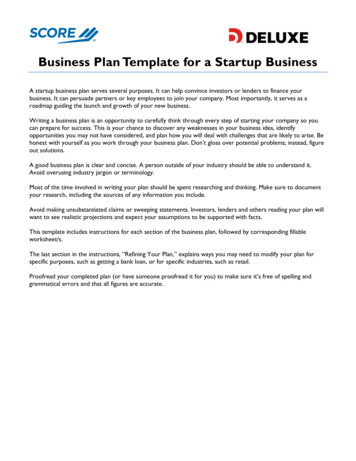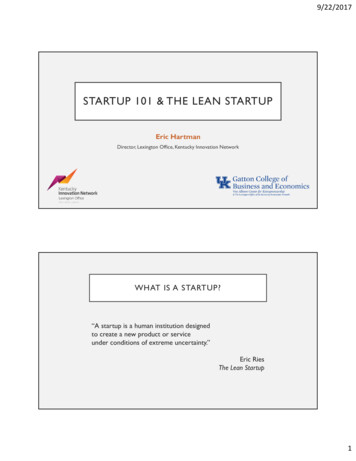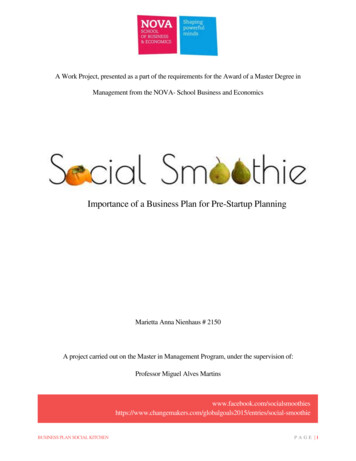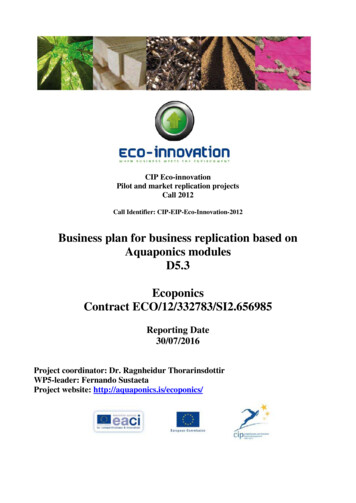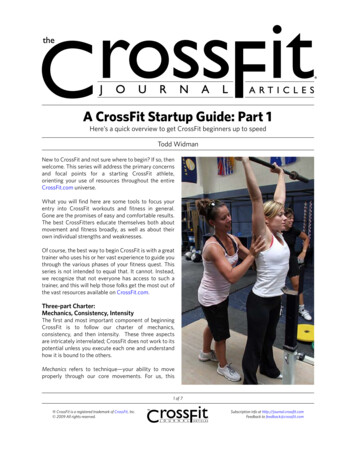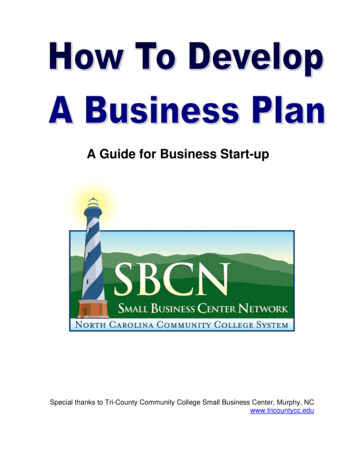
Transcription
A Guide for Business Start-upSpecial thanks to Tri-County Community College Small Business Center, Murphy, NCwww.tricountycc.edu
Overview to the Development of a Business PlanA business plan is more than a means to an end. Most likely the reason you arereading this is that you need a business plan to obtain capital for your business and thatyou are either pursuing equity participation or are applying for a loan. If this is the case,then a business plan will be both essential and critical for your endeavor. If financialsupport is the only reason you are preparing a business plan, then you are making agrave mistake.Most business start-ups fail within three years. They fail for two reasons. The first isthat the business has insufficient capital to operate until cash flow can pay expensesand generate an operating profit. The second is due to poor management. A businessplan is the first line of defense to make sure that your business does not succumb dueto these two reasons. A good business plan is a road map, showing where yourbusiness is going, how it proposes to get there, and the resources needed for thejourney. As such it can also alert you if the business begins to run off-course, allowingyou ample time to take appropriate action. Finally, you also need to understand howyour business will be evaluated and judged as a business especially when you needservices or access to capital.The purpose of this handbook is to act as a self-directing guide to enable you toproperly and correctly develop your own business plan. The SBCN hopes that thisguide will be of assistance to you in completing your plan and securing the capital foryour business.NCCCS ‐ SBCNPage 2
The Cover SheetThe cover sheet is the first page of the proposal. It identifies the: Name, address and telephone number of the businessName, address and telephone number of the ownersDate of the proposal or loan requestIdentifies who prepared the plan, if not the ownerNCCCS ‐ SBCNPage 3
Table of ContentsTable of Contents . . . Page 4Executive Summary .Page 5General Company Description Page 7Products and Services . .Page 9Marketing Plan . Page 10Operational Plan .Page 17Management and Organization .Page 21Personal Financial Statement .Page 22Startup Expenses and Capitalization Page 23Financial Plan .Page 24Appendices Page 27Refining the Plan .Page 28NCCCS ‐ SBCNPage 4
Executive SummaryWrite this section last.It is suggested that you make it two pages or fewer.Include everything that you would cover in a five-minute interview.Explain the fundamentals of the proposed business: What will your product be? Whowill your customers be? Who are the owners? What do you think the future holds foryour business and your industry?Make it enthusiastic, professional, complete, and concise.If applying for a loan, state clearly how much you want, precisely how you are going touse it, and how the money will make your business more profitable, thereby ensuringrepayment.The Executive Summary explains the purpose of this proposal. It should include a verybrief summary of the business as an introduction. Then it should include the basicpoints of the financing proposal. This section is frequently written last and can bemodified for different presentations. The Statement is sometimes called an ExecutiveSummary and should include:1. What is the business? What are its objectives?2. How is the business structured or organized (single proprietor, partnership,corporation, limited liability company)?3. Who are the principals involved in the business?4. Why will the venture be successful?5. What is the total amount of funding needed to implement the plans?6. How will the funds benefit the business?7. How much of the funds are being requested from this funding source? At whatterms (interest, payment rate, time)? What is the ‘deal’ offered?8. What other sources of funding are being considered?NCCCS ‐ SBCNPage 5
9. How will the funds be repaid?10. Why does the loan or investment make sense?11. What are the critical risks and assumptions for this venture? What strategies areplanned to overcome these risks?NCCCS ‐ SBCNPage 6
General Company DescriptionWhat business will you be in? What will you do?Mission Statement: Many companies have a brief mission statement, usually in 30words or fewer, explaining their reason for being and their guiding principles. If you wantto draft a mission statement, this is a good place to put it in the plan, followed by:Company Goals and Objectives: Goals are destinations—where you want yourbusiness to be. Objectives are progress markers along the way to goal achievement.For example, a goal might be to have a healthy, successful company that is a leader incustomer service and that has a loyal customer following. Objectives might be annualsales targets and some specific measures of customer satisfaction.Business Philosophy: What is important to you in business?To whom will you market your products? (State it briefly here—you will do a morethorough explanation in the Marketing Plan section).Describe your industry. Is it a growth industry? What changes do you foresee in theindustry, short term and long term? How will your company be poised to take advantageof them?Describe your most important company strengths and core competencies. What factorswill make the company succeed? What do you think your major competitive strengthswill be? What background experience, skills, and strengths do you personally bring tothis new venture?The Description of the Business should enable a reader to become familiar with thebusiness including gaining a detailed understanding of the product and/or service thatwill be provided. Remember to explain what the product and/or service does forcustomers, as all successful businesses are customer-driven.The goals and objectives of the business should be indicated and, if an existingbusiness, a summary of the history of the business should be included. Some of thekey questions that need to be addressed are:1. What type of business is this (retail, wholesale, service, or manufacturing)?2. Is the business a start-up, an expansion of an existing business, or the take-over(acquisition) of an existing business?NCCCS ‐ SBCNPage 7
3. What isthebusiness’slegalstructure (proprietorship, partnership, orcorporation)? Why have you selected this form? Summarize the ownership ofthe business, and any previous capitalization (share outstanding, management’sinvestment of cash/property?4. When did (will) the business open? What is the schedule of operation? (Hoursthe store is open, days of the week, production schedule, and special seasonalconsiderations.)5. Describe materials and supply sources, methods of production, merchandisingstrategy or how orders are received.6. What will be special/unique about your business?For a new business or new business owners:What experience do you have in this industry?What do you know about the business, and what is the source of your knowledge?In a take-over situation, additional questions must be answered:Why are the owners selling the business?How was the purchase price established?What has been the sales trend? How can you make sales more profitable?NCCCS ‐ SBCNPage 8
Products and ServicesDescribe in depth your products or services (technical specifications, drawings, photos,sales brochures, and other bulky items belong in Appendices).What factors will give you competitive advantages or disadvantages? Examples includelevel of quality or unique or proprietary features.What are the pricing, fee, or leasing structures of your products or services?NCCCS ‐ SBCNPage 9
Marketing PlanMarket research - Why?No matter how good your product and your service, the venture cannot succeed withouteffective marketing. And this begins with careful, systematic research. It is verydangerous to assume that you already know about your intended market. You need todo market research to make sure you’re on track. Use the business planning process asyour opportunity to uncover data and to question your marketing efforts. Your time willbe well spent.Market research - How?There are two kinds of market research: primary and secondary.Secondary research means using published information such as industry profiles, tradejournals, newspapers, magazines, census data, and demographic profiles. This type ofinformation is available in public libraries, industry associations, chambers ofcommerce, from vendors who sell to your industry, and from government agencies.Start with your local library. Most librarians are pleased to guide you through theirbusiness data collection. You will be amazed at what is there. There are more onlinesources than you could possibly use. Your chamber of commerce has good informationon the local area. Trade associations and trade publications often have excellentindustry-specific data.Primary research means gathering your own data. For example, you could do your owntraffic count at a proposed location, use the yellow pages to identify competitors, and dosurveys or focus-group interviews to learn about consumer preferences. Professionalmarket research can be very costly, but there are many books that show small businessowners how to do effective research themselves.In your marketing plan, be as specific as possible; give statistics, numbers, andsources. The marketing plan will be the basis, later on, of the all-important salesprojection.EconomicsFacts about your industry: What is the total size of your market? What percent share of the market will you have? (This is important only if youthink you will be a major factor in the market.) Current demand in target market.NCCCS ‐ SBCNPage 10
Trends in target market—growth trends, trends in consumer preferences, andtrends in product development.Growth potential and opportunity for a business of your size.What barriers to entry do you face in entering this market with your newcompany? Some typical barriers are:o High capital costso High production costso High marketing costso Consumer acceptance and brand recognitiono Training and skillso Unique technology and patentso Unionso Shipping costso Tariff barriers and quotasAnd of course, how will you overcome the barriers?How could the following affect your company?o Change in technologyo Change in government regulationso Change in the economyo Change in your industryProductIn the Products and Services section, you described your products and services as yousee them. Now describe them from your customers’ point of view.Features and BenefitsList all of your major products or services.For each product or service: Describe the most important features. What is special about it? Describe the benefits. That is, what will the product do for the customer?Note the difference between features and benefits, and think about them. For example,a house that gives shelter and lasts a long time is made with certain materials and to acertain design; those are its features. Its benefits include pride of ownership, financialsecurity, providing for the family, and inclusion in a neighborhood. You build featuresinto your product so that you can sell the benefits.What after-sale services will you give? Some examples are delivery, warranty, servicecontracts, support, follow-up, and refund policy.NCCCS ‐ SBCNPage 11
CustomersIdentify your targeted customers, their characteristics, and their geographic locations,otherwise known as their demographics.The description will be completely different depending on whether you plan to sell toother businesses or directly to consumers. If you sell a consumer product, but sell itthrough a channel of distributors, wholesalers, and retailers, you must carefully analyzeboth the end consumer and the middleman businesses to which you sell.You may have more than one customer group. Identify the most important groups.Then, for each customer group, construct what is called a demographic profile: Age Gender Location Income level Social class and occupation Education Other (specific to your industry) Other (specific to your industry)For business customers, the demographic factors might be: Industry (or portion of an industry) Location Size of firm Quality, technology, and price preferences Other (specific to your industry) Other (specific to your industry)CompetitionWhat products and companies will compete with you?List your major competitors:(Names and addresses)Will they compete with you across the board, or just for certain products, certaincustomers, or in certain locations?Will you have important indirect competitors? (For example, video rental stores competewith theaters, although they are different types of businesses.)How will your products or services compare with the competition?NCCCS ‐ SBCNPage 12
Use the Competitive Analysis table below to compare your company with your two mostimportant competitors. In the first column are key competitive factors. Since these varyfrom one industry to another, you may want to customize the list of factors.In the column labeled Me, state how you honestly think you will stack up in customers'minds. Then check whether you think this factor will be a strength or a weakness foryou. Sometimes it is hard to analyze our own weaknesses. Try to be very honest here.Better yet, get some disinterested strangers to assess you. This can be a real eyeopener. And remember that you cannot be all things to all people. In fact, trying to becauses many business failures because efforts become scattered and diluted. You wantan honest assessment of your firm's strong and weak points.Now analyze each major competitor. In a few words, state how you think they compare.In the fina
A good business plan is a road map, showing where your business is going, how it proposes to get there, and the resources needed for the journey. As such it can also alert you if the business begins to run off-course, allowing you ample time to take appropriate action. Finally, you also need to understand how your business will be evaluated and judged as a business especially when you need .
